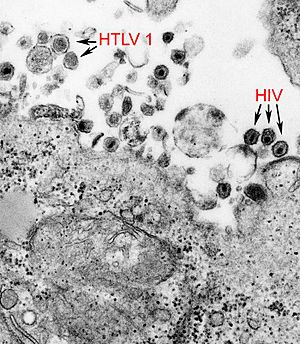Human T-lymphotropic virus facts for kids

The Human T-lymphotropic virus (often called HTLV) is a type of virus. It belongs to a group of viruses known as retroviruses. HTLV can cause serious health problems, including a type of cancer called leukemia and other illnesses. Scientists have found four main kinds of HTLV, which are named I, II, III, and IV.
Contents
What is HTLV?
HTLV is a tiny germ that can infect humans. It is so small that you need a very powerful electron microscope to see it. This virus mostly attacks certain white blood cells in your body called T-cells. T-cells are an important part of your immune system, which helps fight off sickness.
How HTLV is Different
HTLV is a special kind of virus called a retrovirus. This means it stores its genetic information differently than many other viruses. Instead of DNA, it uses RNA. When a retrovirus like HTLV infects a cell, it changes its RNA into DNA. This new DNA then becomes a part of the infected cell's own DNA.
Types of HTLV
There are four known types of Human T-lymphotropic virus:
- HTLV-1: This is the most common type. It is found in many parts of the world. HTLV-1 can cause a rare type of leukemia. It can also lead to a nerve disease that affects how people walk.
- HTLV-2: This type is less common than HTLV-1. It is found in different areas, including parts of North and South America. HTLV-2 is not as strongly linked to serious diseases as HTLV-1.
- HTLV-3 and HTLV-4: These types are very rare. They were discovered more recently. Scientists are still learning about what effects they might have on people.
How HTLV Spreads
HTLV is not spread easily like a common cold. It is mainly passed from person to person in specific ways:
- From mother to child: An infected mother can pass the virus to her baby. This can happen during breastfeeding.
- Through blood: Sharing needles or receiving blood transfusions from an infected person can spread HTLV.
It is important to know that HTLV does not spread through casual contact. You cannot get it from hugging, shaking hands, or sharing food with someone who has the virus.
What Diseases Does HTLV Cause?
Most people who get HTLV do not get sick. They might carry the virus for their whole lives without any problems. However, a small number of people can develop serious conditions.
HTLV-1 Associated Myelopathy
One disease caused by HTLV-1 is called HTLV-1 Associated Myelopathy (HAM). This is a condition that affects the spinal cord. It can cause weakness in the legs and problems with walking.
Adult T-cell Leukemia/Lymphoma
HTLV-1 can also cause a type of cancer called Adult T-cell Leukemia/Lymphoma (ATL). This is a very serious cancer of the blood and lymph nodes. It can take many years for ATL to develop after someone is infected with HTLV-1.
Images for kids
See also
 In Spanish: Virus linfotrópico de células T Humanas para niños
In Spanish: Virus linfotrópico de células T Humanas para niños



